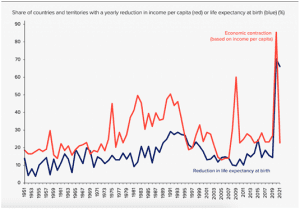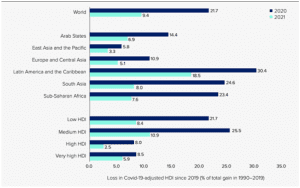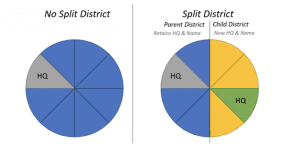DAILY CURRENT AFFAIRS (SEPTEMBER 09, 2022)
THE SOCIAL ISSUES
1. INDIA’S LIFE EXPECTANCY FALLS TO 67.2 IN 2021, DECADE-LONG IMPROVEMENT UNDONE
THE CONTEXT: Life expectancy at birth in India has gone down from 69.7 in 2019 to 67.2 in 2021, undoing a decade-long improvement, a United Nations report has found.
THE EXPLANATION:
• The figures report a global decline, with 70 per cent countries witnessing a decline in life expectancy and 85 per cent countries recording a decline in income in 2020, found Human Development Report 2021-2022 released September 7, 2022.
• The comparison of income and life expectancy also reminds us of the importance of looking beyond income.
• Despite a significant economic recovery in 2021, the health crisis intensified, with two-thirds of countries recording even further reductions in life expectancy at birth.

THE PANDEMIC EFFECTS
• The pandemic has severely affected the human development index (HDI). However, the report globally revealed an unequal impact after adjusting the HDI for COVID-19 losses since 2019 as a per cent of the total gain in 1990-2019.
• The adjustment was calculated by modifying “the expected years of schooling indicator to reflect the effects of school closures and the availability of online learning on effective attendance rates”.
• Latin America and the Caribbean emerged as the most severely affected regions, losing the equivalent of 30 per cent of its pre-COVID-19 progress since 1990. South Asia lost 24.6 per cent while Sub-Saharan Africa lost 23.4 per cent.
• In comparison, Europe and Central Asia lost 10.9 per cent of their pre-COVID-19 progress since 1990, East Asia and the Pacific lost 5.8 per cent and the Arab States lost 14.4 per cent.
• The disparity is even more pronounced when countries are aggregated based on their HDI, with very high HDI countries losing just 8.5 per cent of the progress and low and middle HDI countries losing 21.7 per cent and 25.5 per cent, respectively.
• Globally, a loss in COVID-19-adjusted HDI value equivalent to more than one-fifth of the progress from 1990 to 2019 was recorded, the study noted.

THE ECONOMIC DEVELOPMENTS
2. CENTRE IMPOSES 20% EXPORT DUTY ON NON-BASMATI RICE FROM SEPTEMBER 9
THE CONTEXT: The central government imposed a 20 per cent export duty on select rice varieties, excluding parboiled and Basmati rice. This comes at a time when paddy sowing continues to remain low due to drought in several major rice-growing states.
THE EXPLANATION:
• Trade and market sources said the varieties on which duty has been imposed command a share of around 5.9 million tonnes (mt) of rice exported of the total 21-22 mt (28-30 per cent) of annual exports.
• The total also includes 3-4 mt of Basmati rice that has been kept outside the purview of any export tax.
• The imposition of export tax has fuelled debate on whether the Centre will reach a decision on further extending the free foodgrain distribution scheme – Pradhan Mantri Garib Kalyan Anna Yojana – beyond September.
• The scheme to distribute 5 kilograms of rice or wheat per person per month to nearly 800 million beneficiaries of the National Food
• Security Act over and above their regular monthly quota was started during the pandemic as a welfare move.
• Since then, the scheme has been extended six times – the latest being in April for six months.
• So far, most rice varieties did not invite any export tax. This made domestic varieties cheaper than most global brands, leading to a surge in demand.
• The price of rice variants has risen 6-20 per cent in major markets across the country due to drop in acreage, stoking fears of a 6-10 mt fall in kharif production this year, compared to last year.
• In 2021, India produced around 111 mt of rice in the kharif season.
• Normal area is the average acreage of the past five years. In the case of paddy in the kharif season, the normal area is 39.7 million hectares.
• Given that much of the sowing has happened outside the ideal window and monsoon continues to play truant over Eastern states of Jharkhand, Bihar, Uttar Pradesh, and West Bengal, there is a great deal of uncertainty over the final output.
THE ENVIRONMENT AND ECOLOGY
3. INVASIVE SOUTH RED-EARED SLIDER TURTLE POSES THREAT TO INDIAN BIODIVERSITY
THE CONTEXT: The presence of invasive and non-native south red-eared slider turtles would lead to the extinction of native species of their own kind.
THE EXPLANATION:
• India is home to 29 freshwater turtles and tortoise species of the 356 turtle species recognised worldwide and around 80 per cent of them are threatened, according to a 2020 study published in journal Reptile and Amphibians conservation and Natural History. The paper was published in 2020.
• The red-eared slider is native to south-eastern USA and Mexico but have found their way across the globe including India through trade of exotic animals.
• In India, keeping indigenous turtles as pets is prohibited under the wildlife protection act. But the foreign breeds are not restricted and are kept as pets in many families across India.
• It also not mentioned in the Convention on International Trade in Endangered Species of Wild Fauna and Flora.
• The small and easy-to-maintain species is a hit in the pet’s market. The species breeds faster compared to other local turtle varieties.
ABOUT SPECIES
• The species is considered as one of the world’s 100 worst invasive non-native species. Also, the populations are observed in every continent except Antarctica and at least 73 countries.
• These turtles cannot be culled for sentimental value and other reasons but could be kept captive until their lifespan. These animals can be used for research and teaching purposes.
GOVERNMENT ACTIONS:
• The Union Ministry of Environment Forest and Climate Change has only an advisory in place to streamline the import and possession of exotic live animals in India.
• The government advisory demands registration and declaration of progenies of the imported exotic live species. But there should be more rules to prevent the species from entering our environment and negatively impacting the environment.
4. 39 BENGAL-BOUND EXOTIC ANIMALS SEIZED IN ASSAM
THE CONTEXT: The Assam police seized 30 exotic animals at the Mizoram-Myanmar border.
THE EXPLANATION:
• This was the biggest seizure of smuggled exotic animals in Assam. Two of these animals are joeys or baby wallabies, 19 are chimpanzees and monkeys, 13 small turtles, three large tortoises and two exotic birds.
• The animals have been taken to the Assam State Zoo where their health condition would be assessed, and the species identified.
NORTH BENGAL HUB?
• Assam Forest officials said Myanmar, despite the civil war, has been the source of most exotic animals smuggled into the northeast and then to the “mainland” with northern West Bengal becoming a hub of this illegal trade.
• The exotic animals have been transported within India on two routes so far. One is from Champhai bordering Myanmar in Mizoram and the other is from Moreh, also bordering Myanmar, in Manipur. Animals transported on the second route touch Dimapur in Nagaland.
• Most people arrested in Assam while transporting such animals said they were paid to deliver their consignments in West Bengal, specifically the Alipurduar-Cooch Behar-Jalpaiguri-Siliguri belt.
• This became more than apparent when Forest officials in West Bengal found four kangaroos in the Gajoldoba area of Jalpaiguri in April. Two more kangaroos – one dead, the other injured – were found in the Dabgram forest range.
• The West Bengal Forest officials rescued four monkeys smuggled from Indonesia from a Siliguri-bound bus around that time.
• In July 2020, The Assam Forest officials seized a red kangaroo, six hyacinth macaw, two capuchin monkeys from South Africa and three Aldabra giant tortoises from a truck near the State’s border with Mizoram.
THE SCIENCE AND TECHNOLOGY
5. CHINA’S FULLY SOLAR-POWERED, SEMI-SATELLITE DRONE, EXPLAINED
THE CONTEXT: China’s first fully solar-powered unmanned aerial vehicle has successfully completed its maiden test flight with all onboard systems functioning optimally.
THE NEW MACHINE
• With a wingspan of 164-ft, the drone is a large machine powered entirely by solar panels. The high-altitude, long-endurance (HALE) UAV can stay airborne for long durations.
• Named the Qimingxing-50, or Morning Star-50, this drone flies above 20-km altitude where there is stable airflow with no clouds. This helps these drones to make the maximum use of solar equipment to stay functional for extended durations.
• In fact, the drone’s chief designer told South China Morning Post that it can operate without a break for months, even years.
CROSS BETWEEN DRONE AND SATELLITE
• The fact that the drone can operate in near-space – 20 km to 100 km above the Earth’s surface – makes it capable of carrying out satellite-like functions.
• If satellite services are not available for, say, time-sensitive operations or in case of wartime disruption, then near-space UAVs can step in to fill the operational gap.
• These drones are also referred to as ‘High Altitude Platform Stations’ or pseudo-satellites. China already has this capacity, but the Qimingxing-50’s long-endurance provides an added advantage to make this capability available over a longer period.
• In July this year, the US Army helped test a solar-powered, near-space Airbus Zephyr S drone that set a new record by being airborne for 42 days.
• Both these drones can undertake surveillance missions that require them to stay operational, watching over borders or oceans, for months.
• Drones like the Morning Star-50 are cost-effective to build and are also easy to launch and operate. Being entirely powered by clean energy from the Sun, the present one can help boost China’s capabilities to operate in near-space and over the ocean.
• This HALE UAV is capable of conducting high-altitude reconnaissance, apart from monitoring forest fires, providing communication and environment relay.
THE SECURITY
6. INDIA, UK ORGANISE VIRTUAL CYBER SECURITY EXERCISE FOR 26 COUNTRIES
THE CONTEXT: The National Security Council Secretariat (NSCS) and the UK government jointly conducted the virtual Cyber Security Exercise for 26 countries.
THE EXPLANATION:
• The exercise is a part of the India-led International Counter Ransomware Initiative- Resilience Working Group, facilitated by the British Aerospace (BAE) Systems.
• The aim to organise this virtual Cyber Exercise on Ransomware Resilience is to simulate a large, wide-spread cyber security incident affecting organisations within a country.
• The exercise involved the National Cyber Crisis Management Teams of CRI partner nations dealing with ransomware attacks on multiple electricity distribution companies.
• These companies are responsible for the distribution of electricity to domestic customers and are the last link to the public supply. The exercise explores the complexity of decision-making around response to ransomware on Critical National Infrastructure.
• This exercise has been designed to support the mission of the CRI, and aims to allow participating CRI Members to test their capability to respond to a major ransomware incident; Demonstrates the benefit of sharing information and collaborating during a major incident; provide opportunities for the CRI Nations to share their approaches to countering ransomware.
MISCELLANEOUS
7. QUEEN ELIZABETH II, LONGEST-REIGNING BRITISH MONARCH, DIES
THE CONTEXT: Queen Elizabeth II, the longest-reigning monarch in British history and a symbol of stability in an era of sweeping social and political change, has died at age 96.
THE EXPLANATION:
• During her seven decades on the throne, the British Empire was dismantled and the U.K.’s role in the world shrank dramatically.
• Growing pressure for independence in Scotland and arguments for Irish unification threatened to redraw the U.K.’s own borders, and ruptures within her family raised questions about the monarchy’s future role.
• But at the end, Queen Elizabeth remained head of state of 14 countries in addition to the U.K., and the leader of a Commonwealth that now includes 54 countries with a combined population of over two billion people.
• The new monarch is her eldest son, Charles, whose son, William, becomes next in line for the throne.
• Throughout the years, the queen reigned alongside 15 British prime ministers and 14 U.S. presidents, beginning with Winston Churchill and Harry Truman.
• She ascended to the throne on Feb. 6, 1952, at a time when much of Europe was still recovering from the trauma of World War II.
• Britain was still rationing food at her coronation in 1953, and much of the continent had fallen behind the Iron Curtain. She was still there decades later when the Soviet Union collapsed, and China began its rise as a global power.

